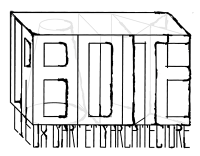- +216 71 772 000
- laboite@kilanigroupe.com
- Monday to Friday, 11am to 5pm.
Elma Riza
«Suivez la ligne»
October 2018 I February 2019
La Boîte
Paysage Filaire is a landscape that emerges from troubled waters, taking shape little by little. A filigree matrix, the structure of an imaginary city with minimal architecture. Something takes shape, at first discreet and fragile. Between simplicity and complexity, little by little the shape takes over the space, inhabiting it, re-drawing it. The line creates links from one point to another; abstraction and association coexist, inviting the viewer to share in a quest for renewal, balance and movement.
This exhibition presents all of Elma Riza’s work in the form of a photo exhibition. The installation-performance “Paysage Filaire” will also be on show.
“Reduction and simplicity, understood as a rule of aesthetics, requires acute concentration and awareness of what each element can represent. For each composition, the aim is to extract the essential. The resulting choices for the final composition have the power to alter our understanding and perception. In one way or another, the works presented here embody the principle of simplicity and reduction, and at the same time evoke associations, leaving behind the formal understanding and materiality of structures. These works play with the possibility of awakening our imagination. They offer the eye both raw, unadorned matter and an opening to the imaginary. (…)
Elma Riza’s works expect us not only to be flexible in our gaze, but also to be flexible in our bodies and to awaken our senses. Her minimal interventions, such as lines of scotch tape, traces of chalk or almost invisible wires, create new perceptions and experiences of the exhibition space. (…)
Dr. Uwe Schramm
Extract from the catalogue of the exhibition On a clear Day? At Kunsthaus Essen, 2017
Elma Riza’s work challenges our perception. Moving from performance, to ́installation, to drawing and sculpture, she makes the invisible visible and gives a temporality that goes against the grain of our everyday lives, awakening the senses of those who take the time to look. It’s a space that’s both poetic and committed, an atypical form of research, where the desire to create sensitive, abstract images and to make them accessible to everyone merges. Ephemeral for the most part, these works invite visitors into a space-time where the ́artist and the viewer find themselves sharing a common experience, in the form of instantaneous, live and documented compositions.
E. R. addresses the theme of the line and its variations as an iconography that is both abstract and conveys (universal) meaning. Many projects have been strongly inspired by the book “A Brief History of Line “1 by the ́anthropologist Tim Ingold, addressing the notions of trace, cartography and territory.
E. R. addresses the theme of the body, on the one hand as a visual element forming part of the composition and in constant dialogue with the forms and spaces created. On the other, as a functional body performing precise actions to give shape to an object, a visual composition in the moment.
E. R. tackles the theme of space and its perception by playing on the visible and the invisible, highlighting existing architectural elements to give them another, autonomous form. A revealed space where the visitor is returned to his or her role as observer.
In 2014, Elma Riza began her research into the line with a series of installation-performances “Between the Lines” in which the geometric line and the body enter into dialogue, imaginary spaces take shape, the body moves through them and modifies them. This “body-image” fuelled her research until 2016. During these two years, she explored several variations of the same working method, developing tools for her research: the reduction of matter, space – in what it has of imaginary or real, immobility – to prolong the moment, movement – in resonance with her linear compositions. His work is also inspired by phenomenology, with the idea of inviting the viewer to experience something both visual and physical.
Since 2016, his work has led him to develop installations, drawings and sculptures, most of which are instantaneous and ‘in situ’. This time, the line redraws real spaces, transforming them. The body s ́ efface to make way for these spaces that have been reinvented or made visible. With the idea of questioning our perception, offering different perspectives of the same space, she tackles themes such as cartography, the mathematical enigma, anamorphosis and the sign.
1 Les lignes, ai-je insisté, sont des phénomènes en soi. Elles sont réellement là, en nous et autour de nous. En effet, il n’est pas possible d’y échapper, car toute tentative de fuite ne fait qu’en poser une autre. (…) Pourquoi la théorie et la métaphore devraient-elles être considérées comme les seules alternatives aux lignes ? Pourquoi la ligne ne serait-elle pas aussi réelle que ce qui passe le long d’elle, si tant est que l’on puisse les distinguer ? Et si l’idée que les lignes puissent être réelles est étrangère à nos sensibilités, alors qu’est-ce qui m’a fait basculer dans ce monde étrange de l’enchevêtrement ? (…) ».
Tim Ingold
Extrait traduit du texte de l’exposition « Lines, A brief history », Rutledge 2007
